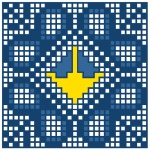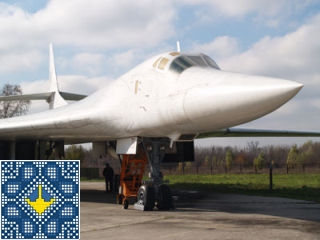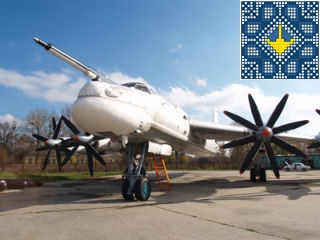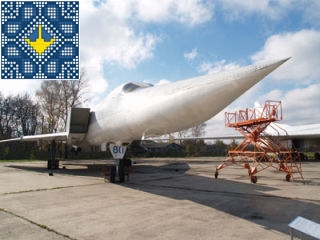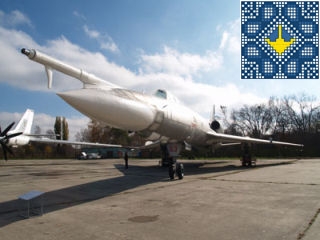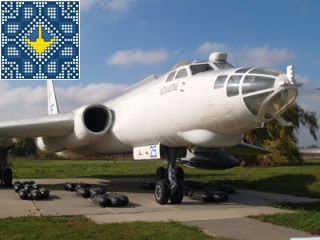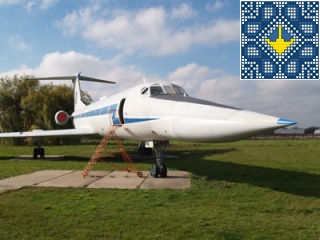|
Poltava Sights | Museum of Long-Range and Strategic Aviation Tupolev Tu-160 Blackjack and Tu-95 The Bear Individual and group tours to Poltava |
Booking of Poltava Museum of Long-Range and Strategic Aviation Tour from Kyiv: Tupolev Tu-160 White Swan - Blackjack is designed to take-off weight of 300 tons, flight speed of 2200 km per hour, variable-sweep wing - the angles 20, 30 and 65 degrees, 4 engines of 25 000 kilogram-force each, crew - pilot, co-pilot, bombardier, defensive systems operator, 12 missiles with nuclear warheads. The procedure of launch of nuclear missiles on base of Tu-160: at the entrance to attack zone lights signal "Start Enabled", then type the code that unlocks a nuclear weapon, bombardier opens one or two bomber hatchs and produce missile launches. Once missle X-55 separated from the aircraft after a while system is activated that puts stabilizers which are located in the normal position inside the missile. Then the missile X-55 descends to an altitude of 50 meters above ground level and continues the flight to pre-set coordinates considering the terrain at a speed of 800 km per hour with a flight range of 2500-3000 km. The deviation of pre-set coordinates is few tens of centimeters. It is an interesting design solutions of tail of Tupolev Tu-160 White Swan - Blackjack that is turned one piece and a special part of the wing - triangle wing operating as an air brake. Taking off on Tu-160 took an average of 46 seconds.
There were built only 64 aircrafts of Tu-95MS. This aircraft was designed for nuclear strikes on territory of United States of America (USA). Flight range is 10500 meters, 6 nuclear missiles, take-off weight of 185 tons, 4 engines of 15 000 kilogram-force each. Tupolev Tu-95MS - The Bear are on combat duty along the coast of United States of America resumed by President of Russia Vladimir Putin. Tu-95MS has four turbojet engines that is configured to work in the most economical fuel mode. These engines are more economical than jet engines - in jet engines to increase the power necessary to increase the fuel consumption - in turbojet engines it is only needed to change the angle of rotor blades. Front propeller of TU-95MS is rotated counter-clockwise, back - clockwise so both propellers create a large flow of air over the wing and at low-speed the aircraft TU-95MS controlled perfectly. Fuel tanks are 86 tons and during the flight the fuel is being used by the same econimic mode with the possibility to make flight up to 12 hours. Soviet pilots were not very fond of Tupolev Tu-95MS - The Bear due to high noise of propellers and the fact that the flight proceeded as very boring and monotonous. Most pilots wanted to fly a jet and supersonic aircrafts. In the cargo hatch of Tu-95MS there is a beam to which are attached six nuclear missiles. Missiles could be released one by one or it was possible to release all the missiles at once. The crew of Tu-95MS never knew exact targets for which they shoot missiles. In the tail of Tu-95MS there is an automatic gun which automatically identifies the object, makes aiming and shooting. In Soviet Union times Tupolev Tu-95MS - The Bear took-off from Ukraine in the direction of North Sea then to England and landed in Cuba with nuclear weapons. This flight of Tu-95MS called "Nuclear Patrol". 90% of flight time of Tu-95MS bombers was with fighter escort of the countries near which took flight: Norway, England, America, Canada and England again. One of the crew members in the tail of Tu-95MS was an observer for fighter escort. In Ukraine there were 23 of Tu-95MS bombers as a part of 1002nd Bomber Regiment "Uzin" near Bila Tserkva. After the decision to refuse of Ukraine of nuclear weapons - 3 aircraft were handed over to Russia for gas debts, 1 aircraft was transferred to Poltava Museum of Long-Range and Strategic Aviation, all the other Tu-95MS bombers were cut for scrap. The pilots and crew of Tupolev Tu-95MS - The Bear never wear parachutes - just sit on them. In case of emergency escape of aircraft crew sits on a wooden conveyor, wears parachutes and through the open hatch leave the plane. Apply a catapult on Tu-95MS makes no sense - too many crew members - seven men so it would be necessary to do a lot of hatches in the fuselage. The Tu-95MS is so reliable that even when stopped three engines it can be on one engine to land safe way. Tu-95MS can be refueled in the air. In Russia the record was set - Tu-95MS flew 43 hours non-stop. Now Russia is reinforced training of pilots on Tu-95MS and Tu-160 flying these aircrafts much more than pilots flew in Soviet times. There was a failure to prepare flight crews - old pilots of Soviet Union (USSR) was no longer able to fly according to age and new pilots were quite inexperienced. Thus is reinforced crew training and a return to a system of training of pilots of Soviet Union (USSR).
The main objective of Tupolev Tu-22M3 - Backfire is the destruction of a potential enemy forces in Europe as well as important strategic objects - large factories, ports, objects of chemical and nuclear industry. Tu-22M3 can carry three supersonic missiles. Each missile weighs 6 tons with 1 ton warhead of TNT or nuclear (2 megatons), the speed of flight - 4000-6000 km per hour, the flight altitude of 22 kilometers above the ground. Automatic gun at the tail of Tu-22M3 fires 4000 shots per minute. In aircraft Tu-22M3 between engines is presented emergency fuel discharge. Tupolev Tu-22M3 - Backfire is filled with 54 tons of fuel and if after take-off there was an emergency - it was needed to remove the part of fuel because of the limited strength of the chassis for landing. If the problem let the crew to circling over the airport - the fuel was burned by Tu-22M3 engines, in case the landing should be done instantly - the fuel under 64 atmospheric pressure jetted into the air till the moment it will left 26 tons with which it was possible to land. Preparations for the flight of Tu-22M3 was the following: crew take their places, start the engines, set the position of wings as far back (65 degrees - minimum size of the aircraft), taxiing to runway, then the wing is set to "20 degrees" and expand the area of wing. As a result the wing looks full of holes but thanks to this it well-blown on the top so Tupolev Tu-22M3 - Backfire could take-off of weight of 124 tons with speed of 370 kilometers per hour. After took-off - landing gear retraction, at a speed of 550 kilometers per hour wing was changed to "30 degrees", continue flying at subsonic speed, then turn on the afterburner, gaining altitude 11000 meters, then the position of wings set far back (65 degrees) and Tu-22M3 start flight at supersonic speed. Tu-22M3 could not go into a tailspin but can falls on the engines. Test pilots tried to bring the plane out of this situation in different ways using afterburner and braking parachutes - nothing helped. But there were exercises in which the pilots at an altitude of 5000 dropped the speed to 370 km per hour with position of the wing "30 degrees" so that was almost stall mode and the plane was shaking all over.
Tupolev Tu-22K - Blinder made its first flight in 1958. The aircraft features: take-off weight of 92 tons, the speed of 1640 km per hour, the two engines on the tail of 16000 kilogram-force each, 3 crew members, range of 5280 km. Tu-22K used to transport different types of bombs but the most of all proved to be as missile carrier. The task of Tu-22K was directing attacks against USA aircraft carriers. In Ukraine there were two regiments of TU-22K - Nizhyn Cavalry Regiment, missile-carrying regiment near Zhytomyr and three regiments were in Belarus. The disadvantage of Tupolev Tu-22K - Blinder was a very bad configuration of the wing with very big sweep. There was also a weak mechanization - take-off was carried out at a speed of 420 km per hour and landing speed was 330 kilometers per hour - is also very high. Catapults of Tu-22K worked just down. The problem was that the catapult ejection at altitude below 240 meters above ground level was not possible. Pilot salary of Tu-16 and Tu-22K differed by 25 Soviet rubles only. The Tu-22K due to design flaws was dangerous for pilots and crew - many pilots simply refused to fly it. By NATO aircraft Tu-22K called " Blinder" because of very limited visibility from the cockpit with the pilot position, just as well when landing - almost nothing can be seen especially in bad weather. Despite all the automation of aircraft the pilot to land the plane must see concrete runway. Strategic aircrafts and civil aviation - are very different in terms of landing. On the landing speed of 340 km per hour - the pilot must visually land the aircraft. On different versions of Tupolev Tu-22K - Blinder refueled from 200 to 400 liters of alcohol so there were problems with alcoholism of maintenance workers. Also there was balon of 6-liter pure alcohol which used to wash the front glass of the Tu-22K. In early 1990 Tu-22K worn out and in 1995 Tu-22K regiments were disbanded and one copy of Tu-22K came to Poltava Museum of Long-Range and Strategic Aviation. The fate of Tu-22K is the same as Tu-95MS - most of them were cut into scrap metal.
Tupolev Tu-16 - Badger - the plane had 30 modifications of various types: bombers, missile carriers, jammers, fuel tankers, aircrafts of maritime reconnaissance, flying laboratory and others. The aircraft served for nearly 40 years. In Poltava there were two regiments of Tu-16 - 185th Missile-Carrying Guards Regiment and 226th Jamming Guards Regiment. Tupolev Tu-16 - Badger as jammers covered the invasion to Czechoslovakia, deployment and withdrawal of troops in Afghanistan. The aircraft Tu-16 in Poltava Museum of Long-Range and Strategic Aviation is equipped with a missile under the left wing as guided cruise missile. Tu-16 could take 36 bombs of 250 kg each at a time or could take one bomb of 9000 kg. On the nose of Tu-16 there is the station "RTI" - the station of reconnaissance and target indication for the detection of enemy air defenses. Landing gears of Tu-16 retracted after take-off during just 45 seconds. Inside aircraft Tu-16 there is an electromechanical winch with cassette holders for bombs. When the bombs are set to cassette holders - the crew screwed fuses which produce slow explosion so the bomb could explode within three days. The designers of Soviet Union (USSR) always were ahead of the designers of USA in creating of cruise missiles. The first cruise missile for missile strategic aircraft designed by designer Sergo Beria - the son of Lavrentiy Beria. He decided instead to design new missile to use smaller aircraft fuselage which flight characteristics were already known thus saving time and financial costs. In USA for test of cruise missiles they were launched with telemetry equipment but in Soviet Union (USSR) in addition it was a place inside of the missile for test pilot. The first test pilot of cruise missiles was Amet-khan Sultan. After the separation of cruise missile from the launch aircraft test pilot monitored flight parameters then overpowering of autopilot controls land the missile at the airfield. The temperature of exhaust gas of TU-16 about 800 degrees Celsius. The aircraft Tu-16 had three 22 mm guns with rapidity of fire - 1200 shots per minute. A runway that was required for landing about 1600 meters with parachutes. In case of hot weather and reduced pressure aircraft Tu-16 took-oof after 2500 meter of the runway. The entire crew was working in oxygen masks which were very uncomfortable. After every 15 minutes all crew members reported on their health condition. There were built 2800 copies of Tupolev Tu-16 - Badger. The aircraft Tu-16 were sold in Indonesia and in Egypt. Regiment of Tu-16 in Egypt was commanded by a former president of Egypt - Hosni Mubarak. Also on Tu-16 was installed location station "Rogovitsa" (Cornea) which provides a safe night group flight of aircrafts Tu-16. Pilots have considered Tupolev Tu-16 - Badger as a very good and reliable aircraft. It was a case in Pryluky when the landing gear jammed. The pilots while landing put the plane on the wing and then took only two weeks to return this aircraft to fly.
Tupolev Tu-134UBL - Crusty - combat training aircraft for pilots. It was cut glass nose of Tu-134, moved the seat of the navigator behind pilot seats, added the nose from Tu-22M3. The aircraft Tu-134UBL was made as the final plane for cadets so they get used to fly aircrafts of long-range strategic aviation. When the bomber coming down for landing - a pilot almost can not see anything in front so the pilot should learn to look to the left to make the landing. Pilots were trained that view from the cabin of bomber is limited. Tupolev Tu-134UBSH is combat training aircraft for navigators. In the fuselage of Tu-134UBSH were equipped twelve seats for navigation of Tu-22M3 on which navigators were trained under the supervision of an instructor. Under the wings of Tu-134UBSH were located pylons for educational bombs. The aircraft Tu-134UBSH made twelve approaches to the shooting range and each cadet-navigator must to drop one bomb at a given point. Thus achieved a cheaper training of bombardier-navigators due to less fuel consumption. Also each of navigatior got quality education and practice. In Poltava Museum of Long-Range and Strategic Aviation there are also such aircrafts as Sukhoi Su-15UM - a fighter with speed of 3000 km per hour equipped with air-to-air missiles and two primary training aircrafts - Aero L29 Dolphin and Aero L39 Albatross. Th new exhibit of the museum since 2020 is helicopter Mi-6A. In the long term collection will replenish by aircrafts Antonov An-24, Mikoyan MiG-29 and Sukhoi Su-27. Unguided Bombs Assignment
All unguided bombs were launched by pre-calculated trajectory considering the force of the wind and aircraft speed. Soviet Pilots Training Program for Long-Range and Strategic Aviation The training of Soviet Union (USSR) pilots for long-range and strategic aviationin was done by special program. The first year - cadets did not make any flights just theoretical and simulator training, the second year - started to fly Aero L29 Dolphin, the third year - bomber Ilyushin Il-28 with group flights and operational use (the bombing was carried out) , the fourth year - were flying at night by bomber Ilyushin Il-28 and study Tupolev Tu-16 aircraft. In summer a fourth-year cadets were sent to regiment of long-range aviation and cadets flew as co-pilots on Tupolev Tu-16 with the regular crews. Here they had exams for piloting and combat use. So after finishing of flight academy all cadets were trained well with theoretical and practical background. When the cadet entered the service in the army he was given only two days to adapt and next the cadet began to fly Tupolev Tu-16. The training system has been at a high level so that the cadets upon arrival at the place of service were ready to carry out their mission. In USA each second co-pilot became the commander of the aircraft, in Soviet Union (USSR) only one of ten pilots became the commander of the aircraft. Normal lag from a predetermined position on the route must be within 2 seconds. If the lag was in the range of 30 seconds was required a major adjustment. To become the first pilot of Tu-16 after flight school it was needed 1-4 years depends on ability of the cadet. In order to became commander of the aircraft and got a first class required minimum of ten years after the flight school. In the days of Soviet Union (USSR) was so much competition among pilots and move to a higher level of aircrafts was very difficult. Cadets all the time passed continuously tests of theory and practice, physical training and also there was an important factor of good health. For Tupolev TU -22M3 aircraft was selected only one of 150 pilots. Pilot in the preparation always was asked if he wants to change aircraft to a new one or different type. If the pilot refused to change then he was not punished. Soviet and USA Pilots Training Program for Civilian Aviation USSR In Soviet Union (USSR) Civil Aviation pilot finished flight school on base of Antonov An-2 then had two years to work by Antonov An-2 on chemically treated fields as co-pilot. If all is well the pilot then became commander of Antonov An-2. Then at least 1 year the pilot flew as the commander of Antonov An-2. Then the pilot transferred to Antonov An-24 as co-pilot and had to fly 1 year then he became the commander of Antonov An-24. Then one year - on Tupolev Tu-134 as co-pilot and became the commander of Tupolev Tu-134. That is so consistently held growth of pilot experience so when he made flights Ilyushin Il-62 to carry passengers abroad - he has been the average age and has made a huge hours of flights on the many types of aircraft. A good landing is considered to be the minimum vertical speed. When Aeroflot aircrafts were landing abroad all pilots went out to look at the higher skill of Soviet pilots. The system of education of Soviet pilots was to prepare them for any possible situations. As proverb "All that known on the ground at mark "5" - in the air known at mark "3". Soviet pilots constantly checked - once a year was mandatory landing on one engine at night. A pilot who can not fly - no one needs so the system of Soviet Union (USSR) pilot training, proper selection and education of pilots - was correct and greatest in the world. USA The army system works similar as in UA / USSR and commercial aviation works totaly different. For private is that a young cadet have to go to aviation school and learn Avionics, Navigation, Tecnic, Weather airmanship and Laws it took around 1/2 years. Meanwhile a cadet fly with an flight instructor around 40 hours and only if he and the chief instructor are sure the cadet is save and can pass the test he goes to Test. If a cadet do not ready he do not even enter the Test flight. Then a cadet have to fly a special program where he have to demonstrate manual flying and radio operation and if he pass - get PPL flying paper. So then the young pilot is allowed to fly small airplanes less than 2 Tons with 1 Motor VFR (not Instrumental). Next when the pilot have some flying time he can go for IFR which is same effort as before or more if he goes for commercial airline or airline then similar but he can have Private IFR which means now is permited to fly lower than 2 tons with 1 Motor in Clouds and if he did commercial it is more than 1 Motor (but no turbine!) and 5600 kg or 19 People and if he did ATPL the pilot have same limits but he had much more law and learned turbine as well. And then when he find someone who let him fly then he need type rating of each machine. Soviet-American Operation Frantic In 1944 president Franklin D. Roosevelt asked leader of Soviet Union (USSR) Joseph Stalin to let bombers B-17 landing on airfields of Soviet Union. Has been allocated three airfields: Poltava (bombers) , Myrgorod (bombers) and Piryatin (fighters). 15th US army flew out of Italy and 8th US army - of England then the bombing was carried out on the territory of Germany and landing - on Soviet Union (USSR) airfields. In Soviet Union (USSR) airfields carried out maintenance, refueling and re-installation of bombs and B-17 aircrafts departures for the new bombing over Germany. Such departures was made more than 12 times. The last time when group of B-17 bombers flew over German a spy aircraft flew with them and has made photographs of Soviet airfields on which landed bombers B-17. Then during the night of 21st-22nd of June 1944 was done airfield airstrike by special German aviation group "Condor" consisted of Junkers Ju 52 and Junkers Ju 87 Stuka. It was destroyed searchlights, anti-aircraft guns and then destroyed about 47 copies of B-17 bombers and around 50 other aircrafts. You could visit Ukraine Poltava Sights | Museum of Long-Range and Strategic Aviation | Tupolev Tu-160 (Blackjack) and Tu-95 (The Bear) with Ukraine Grand Aviation Tour |
Ukraine Grand Aviation Tour | Top Airplanes and Helicopters | Video |
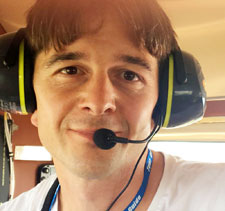
Book your tour or request information: |
|
- please, look at reviews of tourists about our tours
|
© 2011 - 2022 All rights reserved |
